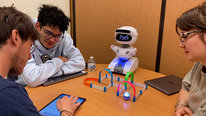- Megan Elwood Madden
- Professor
- Presenter’s NSFRESOURCECENTERS
- University of Oklahoma
- Alisa Kotash
- Postdoctoral Research Associate
- Presenter’s NSFRESOURCECENTERS
- University of Oklahoma
EAGER GOLD-EN Rewards: Removing barriers and supporting geoscience diversity ...
NSF Awards: 2037455
2022 (see original presentation & discussion)
Undergraduate, Graduate
Geoscience remains one of the least diverse STEM fields in the US. Growing and sustaining diversity in Geosciences, and across academia, requires addressingcampus and departmental climate and culture, including ways to formally recognize those who are DEI advocates. However, efforts and intense work done to improve diversity, equity and inclusion (DEI), revise existing policies, and redress biases often go unrecognized and are often undervalued. This work also takes significant time and energy, which would otherwise be dedicated to other, often more explicitly valued, forms of research/teaching/service.
Our project aims to investigate the current value of DEI work in faculty assessment structues across various Geoscience departments in the US through surveys and interviews. Preliminary results indicate that Geoscience departments are engaged in a wide range of DEI work, but more than 70% of interviewees perceived that faculty DEI work is not considered in their department's formal faculty evaluation system. In addition over 85% perceived that DEI work within their program falls disproportionately on women and early career faculty. Interviewees reported that while personal experiences and awareness motivate their DEI work, the main hurdles to engaging in more DEI work include lack of 1) time/equitable workload distributions, 2) clear expectations in evaluation criteria, 3) funding and other resources necessary to systemically blend DEI efforts into research and teaching.
Related Content for Recognizing and Rewarding DEI work in Faculty Evaluation
-
 2022Portraits of Giving Back by Native Individuals in STEM
2022Portraits of Giving Back by Native Individuals in STEM
Nuria Jaumot-Pascual
-
 2022The Extremophiles
2022The Extremophiles
Brooke Coley
-
 2022How are U.S. workers using their numeracy skills?
2022How are U.S. workers using their numeracy skills?
Maia Punksungka
-
 2018Engineers Leading Inclusive Dept. Culture Change: TECAID
2018Engineers Leading Inclusive Dept. Culture Change: TECAID
Gretal Leibnitz
-
 2022Impact Study: STEM-Innovation and Design (STEM-ID) Courses
2022Impact Study: STEM-Innovation and Design (STEM-ID) Courses
Meltem Alemdar
-
 2022Florida Transfer Student Pathways to Success in Microbiology
2022Florida Transfer Student Pathways to Success in Microbiology
Alexandria Ardissone
-
 2022CUAHSI & the Data Lifecycle: CyberInfrastructure for Water
2022CUAHSI & the Data Lifecycle: CyberInfrastructure for Water
Clara Cogswell
-
 2022Designing Innovative AI to Support K-12 Collaboration
2022Designing Innovative AI to Support K-12 Collaboration
Rachel Dickler


Stephen Alkins Ph.D.
Diversity, Equity, Access, Inclusion, and Belonging Officer
This work is incredibly relevant and crucial. This supports having some level of accountability at the systemic level. Thank you for the presentation,
I'm curious, could you say a bit more about what incentives faculty reported to attend or engage in DEAIB-related learning opportunities? Some of it is also a dance of what level of activities are provided in institutional settings. To that end, what pushback have geosciences faculty reported for strategies like this?
Also, to what level are geosciences faculty promoting DEAIB as essential components of their research? My personal belief is that to make concepts and practices systemic, DEAIB impacts should be required sections of NSF proposals in the way that "Broader Impacts" and "Intellectual Merits" are essential components.
Megan Elwood Madden
Professor
Dr. Atkins, Thanks for your questions and comment! The faculty we interviewed reported varying levels of training and learning opportunities offered/required at their institutions. Many reported that more learning opportunities/trainings would motivate them to do more DEAIB work. Many also reported that they would be more motivate if the work was collective- multiple faculty of faculty/students engaging together.
When we asked in the survey about the faculty member's personal engagement in DEAIB work, integration into research was selected at the lowest rate amongst the 4 options (learning/trainings, teaching, service, or research) with slightly over half reporting DEAIB work associate with research. In the interviews, many of the faculty who reported DEAIB engagement in their research had funding to do so, which supports your belief that if funding agencies (or institutions) provide resources for this work, faculty are more likely to engage.
Stephen Alkins Ph.D.
Brian Drayton
Dr. Madden,
Your work is especially helpful because of the kinds of data you've collected.
I am interested by your anwer here-- the relatively low level of DEAIB engagement in research. I wonder if a key barrier is lack of clarity about how to do this– and an important response would include people workshopping their ideas or dilemmas with peers? Can some of this be done virtually? Seems like a great topic to network around.
Megan Elwood Madden
Professor
Dr. Drayton,
You raise an excellent point about clarity of expectations and methods for documenting DEAIB work in research. One of our primary recommendations for improving motivations is to explicitly document and reward DEAIB work in all areas of faculty evaluation- teaching research and service. This includes providing diverse examples of what this work might look like. For example, within research it might include developing clear lab of field guides and protocols that communicate expectations to all researchers, including expectations of communication, data sharing, inclusion of colleagues in publications, and safety plans. Or it could be a community engaged project that results in policy development rather than journal articles. Clarity and examples are key.
Gregory Goins
Professor and Chair
This topic is strong due to the relevancy of it and relatability factor that it has. Your solution was clear cut, and I enjoyed seeing the real research you have conducted and are conducting surrounding this.
Kenne Dibner
Senior Program Officer
Love to see this working happening in the Geosciences where it is so crucially needed. I wonder if you have any insight into whether or not participation in the DEI work of professional societies and organizations has helped junior faculty in making their own efforts visible in their promotion and tenure efforts. Anecdotally, I've heard that some of the work that AGU is doing (i.e. Thriving Earth Exchange) can help faculty more effectively integrate DEI work into what they are already doing.
Megan Elwood Madden
Professor
Unfortunately, we have not seen professional society mentioned significantly in the interview and survey responses. The recent URGE pods were mentioned frequently and folks were excited to participate in those discussions with colleagues and work collaboratively to create policy/resource change within their institutions. The collaborative component seems to be a positive for many faculty- many want to be doing this type of work within a team, not on their own.
Kauser Jahan
Much needed dialogue. Excellent work.
Brooke Coley
This work is powerful and much needed. Institutions should incorporate DEI as standard in evaluating faculty members, it cannot just be on the faculty members and their moral responsibilities. DEI should be introduced in the evaluation. What did faculty members mention as incentives for them to be involved in DEI work? Did they mention about intrinsic motivation only?
Megan Elwood Madden
Professor
Dr. Coley,
Faculty mentioned having clear expectations around DEI work (within the context of Tenure and Promotion) as one of the incentives. They also indicated that if there were collaborative efforts, with training and resources, this would be an incentive. Overall, clarity in expectations, collaboration, funding, and time were two resource incentives that faculty mentioned as motivators to do more DEI work. Faculty want their work to be recognized and valued in meaningful ways that elevate the efforts.
Brooke Coley
We are conducting a related study in engineering where we investigate what faculty feel to be their responsibility in establishing and/or advancing antiracist and inclusive academic environments. We believe some of this also is centered in the values held and prioritized by faculty and the greater STEM academic culture. Where can we gain more information about the instrument used to conduct your national survey on faculty? We are working to establish a similar instrument and would be curious to know more about the items selected for inclusion on your instrument.
Barbara Rogoff
Thank you for this important work!
Ann Podleski
It is encouraging to see that geosciences is seeking to increase diversity, equity and inclusion. I did see that addressed at some of the sessions at the AGU annual meeting in 2019. And I think that recognizing and rewarding work in DEI is a key factor and appreciate the efforts to identify some logistics that can help faculty become more engaged in DEI. Being a component (in some way) that can be considered for faculty evaluation is a positive step, but it needs to be more that a "checkbox" and I think the efforts to survey and interview faculty and interview faculty is valuable. Thanks for the work that has gone into this. (And maybe with the virtual meeting options we are all so familiar with now, this can help get more voices heard.)
Megan Elwood Madden
Professor
Dr. Podleski,
Thanks for your comment. Yes, I agree that it needs to be more than a "checkbox". In both the interviews and the surveys it is clear that faculty want their efforts to "count", but that they don't think it would be a good idea to required DEI work of everyone, at least not yet. This can be a bit complicated to navigate in practice, but we are working on recommendations that departments can try.
Ann Podleski
I am not sure that requiring DEI work of everyone is the best strategy, but recognizing that it is valuable and a contribution to the university that is worthy of being one of several different choices of "service" or some of the other standard categories that are considered for promotion and tenure seems reasonable.
Megan Elwood Madden
Professor
Many faculty we interviewed agreed that it should not be required of everyone, but for those that are doing DEI work it should be valued and rewarded. There was also a general consensus that it needs to be recognized and valued in ALL areas of faculty work, not just service. Inclusive teaching, diversifying courses, working on community engaged research, practicing culturally responsive graduate advising, etc. all need to be valued and rewarded.
Ann Podleski
Exactly - I think it has a place in all of the areas, but maybe place to start is to look for it in at least some areas (as appropriate for the specifics of the university community).
Jonathan Lewis
Thanks for this important work. I'm doing some things in this realm and one thing that concerns me, and that I don't know how to address, is that fact that tenure and promotion are committee processes and thus unpredictable (even fickle). Have your surveys revealed emerging best practices for changing T&P policies to value JEDI contributions meaningfully?
Megan Elwood Madden
Professor
Dr. Lewis,
Unfortunately, we have not found examples of T&P policies that are doing this well- but we would love to see them. We have been collecting ideas from the literature, but the lack of concrete examples is frustrating. We are hoping to develop some example language that we can test in departments here and hopefully share with others outside our institution, but testing/seeing an impact will take time. We are also working on example language for annual evaluation, which could see more immediate results.
Jonathan Lewis
Further posting is closed as the event has ended.